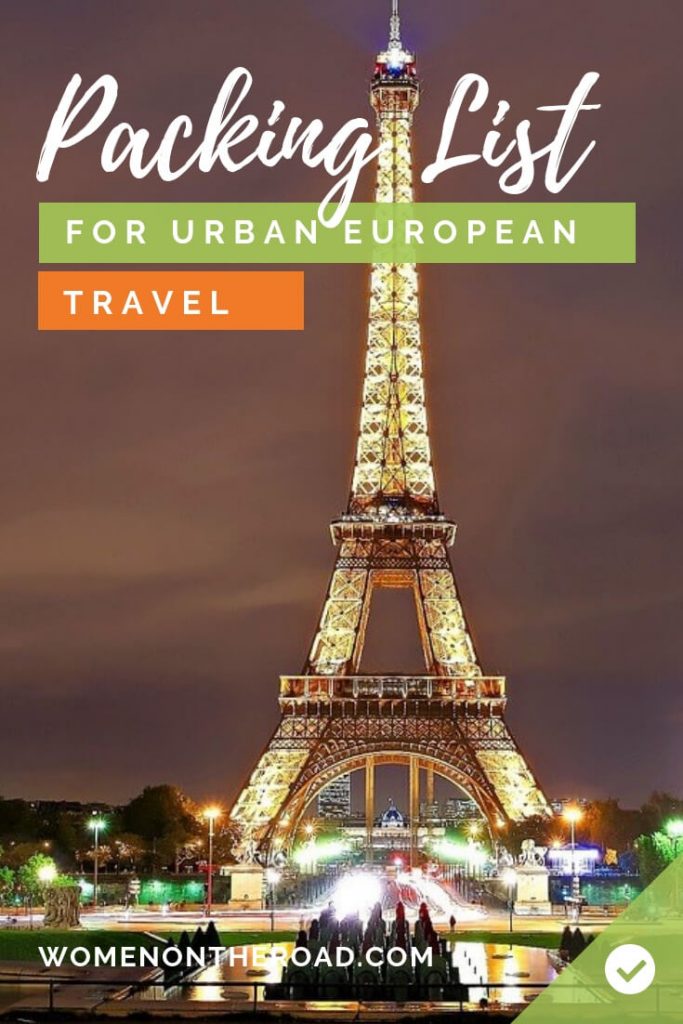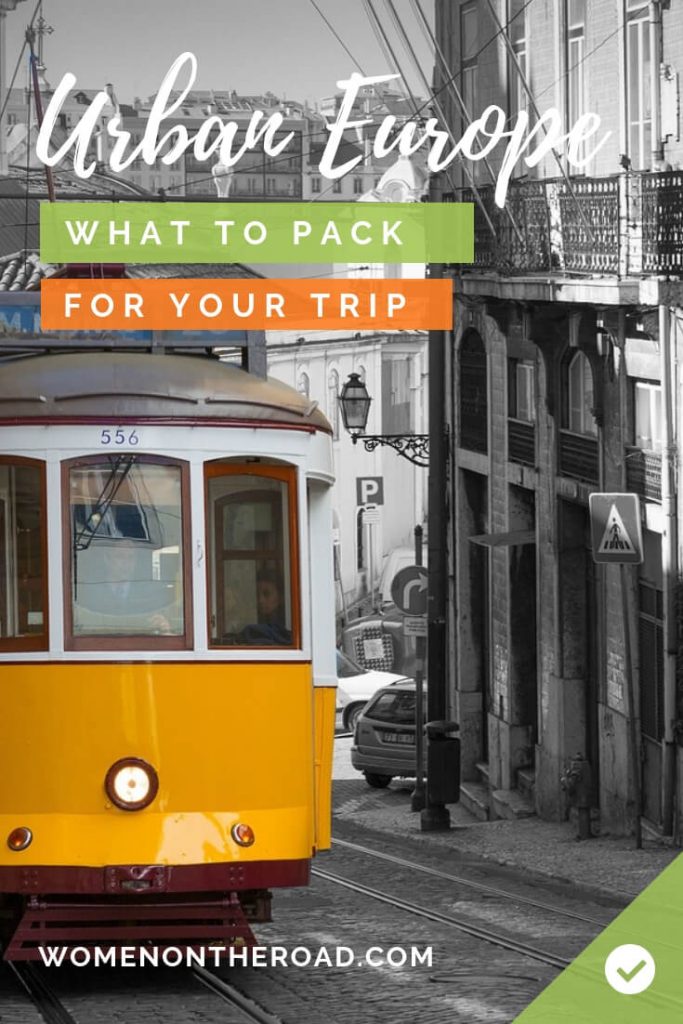Putting together a packing list for Europe is a bit like putting one together for “America” – would that be Hawaii in summer or Alaska in winter?
Seriously, there’s no way to cover all of Europe, all of the year. So let’s start with what I consider the most agreeable travel season: a packing list for Europe in summer. And because that can mean beach, mountain and everything in-between, let’s focus on urban travel.

What follows is a list of Europe travel essentials, or simply put, how to pack for Europe.
A caveat: I travel light. I might take 2-3 pairs of underwear for a week or two, but wash a pair every night. My bags are always only 3/4 full when I leave home because I know I’ll find something I like during my travels.
Take this list – and change it! Adapt it to your needs, add things, remove things, but at least you’ll have something to start from. There’s nothing worse than a blank page.
NECESSITIES AND ESSENTIALS FOR EUROPEAN TRAVEL
Some things you simply cannot do without, and some things you could do without, but shouldn’t. These two apply to pretty much everything on this European packing list.
Packing checklist for Europe: what you can’t leave without
- Your identity papers: Passport, identity card if you’re from a country that has one, and any other ID you might need.
- Requisite travel visas: If you’re coming from the UK, you know Brexit is affecting the way you travel. If you’re coming from Asia or Africa, you may well need a visa to Europe. Make sure you check visa regulations and get the necessary paperwork done before you buy your ticket. Laws and visa requirements change all the time so just because you checked last time you traveled doesn’t mean you shouldn’t check again.
- Plane or train tickets: Once you get to Europe, you’ll have several options for transportation. You may wish to rent a car (here’s the comparison engine I use to find the lowest prices) or fly on one of the cheap regional airlines. My own personal choice is to travel by train whenever I can, usually using a train pass to keep costs down when I’m trying to pack a lot in. Here’s where I explain about train passes and how to use them.
- Health insurance card or policy: If your health insurance covers you in Europe, perfect. Bring your card along. If it doesn’t, please make sure you buy health insurance before you leave home. Health care in Europe can be expensive if you’re not covered. If you’re not sure what to get, here’s a comparison chart for insurance where age is not much of an issue. (Not convinced you need insurance? Read this and possibly change your mind.)
- International vaccination certificate: Whether you need this for Covid or because you’re arriving from a country where communicable diseases are widespread, take the certificate seriously or you may be denied entry without it.
- Money: Obviously, but bring the right kind of money. A large part of Europe – but not all of it – uses the Euro, so if you’re landing late at night when airport change offices might be closed, it would make sense to bring a bit of cash with you. Conversely, there are ATMs everywhere, so get a good prepaid card or a debit card with low charges and good currency exchange rates before you leave. Most European card machines are made for smart cards with chips.
- Emergency phone numbers: I’ve placed this in the ‘must have’ list because although you probably won’t need it, you might. A physical list should complement the one on your phone and flash drive and include embassy contacts, next of kin and your hotel phone number in case you get lost (you’ll be happy to have your physical list if you drop your iPhone into the toilet, trust me).
- Your medications: Take whatever you use regularly, along with your medical prescriptions so that you can refill them if needed. If your medication is rare or complex, ask your doctor for the chemical composition because often, you can get the same thing in Europe but under a different name. If you wear glasses, bring your prescription along and if you wear contact lenses, don’t forget your supplies (you can keep them organized with this kit)
- Packing cubes: These to me are not optional. As far as I’m concerned, packing cubes are travel essentials for Europe. Not only will you be able to pack more into a smaller space, but you’ll be all the more organized for it.
Optional (but recommended) on your Europe travel packing list
- Discount cards: If you have any senior discount cards, bring them with you. Many European countries give discounts when you’re over 55, 60, or 65, depending on the country and purpose. Your ID with your birthdate is usually enough, but better safe than sorry so if you have an extra bit of ID, bring it along.
- A travel guidebook: You can bring along the book itself or a download – both have advantages and disadvantages. The downloads are often incomplete, but are internally linked and easy to navigate. Books are more complete, with perhaps more information than you need. Here’s a rundown of some of my favorite guidebook series.
- A map app: Many people swear by Google Maps but… I like the simple clarity of Maps.me. I just download the maps I need before I go and use them offline as I travel.
- A travel journal: Not everyone desperately needs one of these but to me, the right travel journal is near the top of my Europe travel checklist.
- Driver’s licence: Your national licence will often be enough if you want to rent a car and drive around for a few weeks. Some countries, however, require an international licence, so check first.
- Travel money belt: When contemplating things to bring to Europe, this item always makes the cut for me. It may not be pretty, but it’s one of the safest ways to carry your money. There are other options to safeguard your valuables, like a neck wallet or an anti-theft bag, but one doesn’t preclude the other and I usually have the bulk of my cash and my passport in a money belt, and my daily stash in my cross-body bag or purse.
- First aid kit: First aid items aren’t essentials for Europe, because you’ll find a pharmacy on every street corner, but you might feel more comfortable with a few items whose brands you prefer.
PACKING FOR EUROPE: CHIC OR CASUAL?
Travel clothes for Europe don’t need to be complicated or overly stylish. Just bear in mind that Europeans may dress up more than you’re accustomed to, at least in cities. While no one will balk if you run around in your Nikes and sweat pants, you’re the one who might feel a little out of place (unless you’re jogging in the park, that is).
Think smart casual for evening wear, and for daytime, nice-looking pants or a skirt with a simple top will do the trick pretty much everywhere. If course, you could go high-style and latest fashion, but as a traveler, you probably won’t be particularly comfortable (unless your driver and limousine are waiting at every curb).
These items should go on your Europe packing list
A reminder that I pack lightly, so you may be tempted to add to this list. Just keep in mind that airlines are becoming increasingly stricter about weight and size restrictions, and calculate everything before you shut that suitcase or you might be hit with extra charges at the airport.
- 2 pair of pants/trousers: Dark-wash jeans are a classic, as are any well-tailored casual slacks. Denim is fine as long as it’s not “sweaty” summer – get the lightest, airiest pair you can find
- 1 pair of comfortable leggings or palazzo pants – something stretchy is great for the plane and for wandering around in your room
- 1 wrinkle-free washable travel skirt or a travel dress you can spruce up with a scarf
- Speaking of scarves, consider a lightweight pashmina or an infinity travel scarf (with hidden pockets!)
- 1 pair of shorts if you’re headed to the coast for a day trip (if not, leave these at home)
- 2 blouses (short- or long-sleeved, depending on the exact season – May and September may require longer sleeves)
- 1 tank top (for layering or sleeping in)
- 1 cardigan, lightweight fleece or for warmth on chilly evenings
- 2 quick-drying underwear (more if this is too scary)
- 2 travel bras – just make sure they’re quick-dry so you can wash one as soon as you get in from all that sightseeing
- 1 bathing suit (if you’ll have access to pool or sea)
- 2 pairs of shoes (sandals for sightseeing or evening wear and walking shoes if you plan to do some serious walking)
- 1 travel towel (if you’re staying in a hostel; a hotel will provide its own)
- Rain gear: a classic trench coat, or a waterproof poncho for emergencies, and an umbrella for your purse
- Funky jewelry (not the real stuff!)
- A travel handbag or purse (I insist on wearing a cross-body for safety reasons, but you might also consider using a daypack if you prefer)
PACKING LIST FOR EUROPE: PERSONAL ITEMS
On your Europe packing checklist, you’ll have plenty of items you’ll need but may decide not to take. These are items you can easily find in Europe, but you may have small containers or ends of bottles and you might as well bring those along and finish them off.
- Shampoo/Conditioner or a kit with everything
- Hair accessories (hair clip or barrette), comb, brush (most hotels have hair dryers, plus yours may be of the wrong voltage – it’s not something I would bring)
- Toothbrush and toothpaste and dental floss
- Hand sanitizer – don’t worry, you’ll find this everywhere in Europe, you just need a small amount to get here
- Small moisturizer
- Small deodorant
- Nail clippers or file, tweezers
- Disposable razor
- Comb or hairbrush (like this mini one)
- Lip balm with SPF
- Make-up and remover
- Dramamine or motion sickness bracelet (I tried these and they worked!) if you suffer on the road
- Pads/tampons/diva cup if needed, and panty pads
- Neck pillow for the plane or long rides (this one doesn’t require inflation)
- Eye mask and earplugs if you need them
- Sunglasses
- Sunscreen (you can just buy this when you land)
TECHNICAL ESSENTIALS FOR TRAVELING TO EUROPE
Many of these are essentials when traveling to Europe and they are probably things you would consider taking anyway. Some might be new to you so have a read and make sure you’re not left empty-handed at the other end!
- A flashlight is one of the things I never travel without (find out why here)
- Portable luggage scale – this is optional, but important if you’re flying discount because weight restrictions are getting ever more stringent and guessing luggage weight could be costly
- Universal adapter – you’ll be able to use it everywhere in Europe but also elsewhere in the world, wherever you travel
- Pens or other things to write with (check out this Space Pen!)
- Phrasebook or language translation app
- Books or Kindle (if you don’t want to pay to buy a Kindle, you can download the app and read all your Kindle books on your phone or tablet)
- Phone paraphernalia – charger, cards and unlocked cellphone if you plan on buying a local SIM
- Portable external charger because with all that phone use for language apps and maps, you’ll drain the battery quickly (and don’t expect to find electrical outlets everywhere)
- A camera if you’re not using your phone to take pictures
- A music player, also if you’re not taking your phone
- A USB key – use it to keep copies of your important papers and carry your documents if you don’t plan on bringing a laptop
- A laptop if you plan to work or write while you’re away (I’m an Apple person and take my Macbook Air everywhere)
- A VPN, or virtual private network – this keeps you safe while you surf and prevents anyone from stealing your identity or getting into your accounts
PACKING LIST FOR TRAVELING TO EUROPE IN ALL SEASONS
Like everywhere, seasons change and so should your things to pack for Europe. The above list should be the core of your list, but you could add/exchange the following depending on the season.
Packing list for winter in Europe
Winter means different things in different countries, and can range from mild autumnal temperatures in southern Europe to deep-freeze in the far north. Even so, there are certain basics of winter that are valid in most places. (Click here for a full guide to cold weather clothes for winter travel.)
Here are the essentials for your packing list for Europe in winter:
- If your winter is mild, bring a fleece and use several layers to keep warm. If you’re heading into the cold, one of those lightweight down jackets (like these) that roll up into nearly nothing should do the trick.
- Don’t forget the extras – scarves, hats, gloves. You can easily get these in Europe quite cheaply but I’m mentioning them only to remind you.
- Some hand-warmers might be a good idea, but buy those locally in a sports store rather than carrying them on the plane.
- Although you’ll be snug pretty much everywhere in winter, unseasonable cold in otherwise warm climates often mean a lack of heating, so bring your flannel PJs or a warm fleece and leggings for indoor wear.
Packing for summer in Europe at the beach
The main Europe travel necessities for summer are included in the above list, but if you’re headed for the beach, consider these additional items:
- flip-flops or thongs or whatever you call those plastic sandals
- a dry bag for your camera or cell phone
- sunscreen – I mentioned this already but it’s important enough to mention twice
- a portable or collapsible water bottle like this one
WHAT TO WEAR IN EUROPE: A FEW DO’S AND DON’TS
- DO buy it there. Urban travel rarely requires more than a carry on, but European budget airlines have extremely strict baggage restrictions. You can easily purchase toiletries once you land – most of the brands you know, but plenty of new ones to experiment with.
- DO wear comfortable shoes. While those heels give off that Eurochic vibe, you’ll truly regret your decision after the first few cobblestones.
- DO choose neutral tones. Not only do greys and blacks mask dirt, grime and wrinkles, but they are always in style. You won’t stand out in a crowd as a tourist, and that can help keep you safe. Additionally, muted colors allow you to mix and match your wardrobe – and pack fewer items.
- DO leave it at home. Dispense with jewelry. Certain cities are notorious for pickpockets and you don’t want to spend half a day reporting a theft at a police station. Use a money belt or an anti-theft bag to hide your valuables.
- DO dress it up. The best way to up your style factor is to wear attractive scarves. I always take a few when I travel – not only do they dress me up but they help me pack less because I can “change outfits” more often by simply changing my scarf. Another accessory that can easily dress up a wardrobe during the day is a pair of designer sunglasses.
- DON’T stuff your carry on. You’ll want space in there for the return trip. European cities have all kinds of amazing shopping! Even though I’d leave the tacky souvenirs at the gift shop, you can find leather purses, handmade trinkets and other amazing items you’ll want to take home. Make sure to leave them space.
- DON’T second-guess the weather. Check the forecast before you zip your bag shut and pack accordingly. And if you’re going somewhere you’ve never been, check the average temperatures (you can start with this weather chart).
- DON’T be too casual and dress for the beach in the city. Showing a lot of skin is considered ill-mannered, and even shorts are frowned upon unless your city happens to be in the deep South or by the sea.
- DON’T overthink it. While travels in the wilderness require a lot more forethought and planning, city travel is much more “normal”. Not only are there stores everywhere to help you fill in the blanks if you forget something, cities in Europe are probably not all that different from cities you’ve visited back home. A tinge more formal, perhaps, but buzzing and exciting nonetheless.
— Originally published on 24 December 2018
PIN THESE PICTURES AND SAVE FOR LATER!



